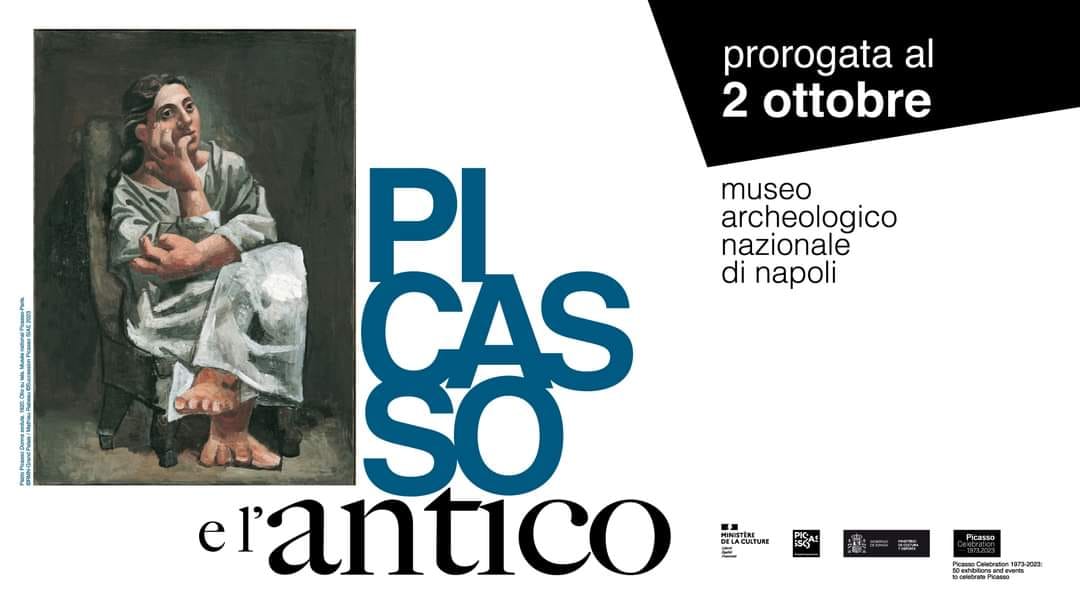Picasso and classical antiquity
Exhibition
5 April - 2 October 2023
Hours
The exhibition "Picasso and classical antiquity", curated by professor Clemente Marconi, is part of the international project “Picasso Celebration 1973 – 2023: 50 exhibitions and events to celebrate Picasso", for the 50th anniversary of the artist's death.
Set up in the rooms of the Farnese collection, the temporary exhibition consists of two parts: the first part deals with the Neapolitan stays of Picasso, when the artist had the opportunity to visit the National Museum, at a time when it had not yet reached its current "archaeological" status, because it still contained the Farnese Picture Gallery, then moved to Capodimonte in 1957; the second part develops a comparison between some works of art of the Museum and some of Picasso's works.
How deeply Picasso's journey to Italy in 1917 influenced his future artistic production has long been acknowledged by art historians and represents a fundamental point of critical studies. Indeed, the works of art that Picasso admired in Rome, Florence and Naples are ascribed a special importance as a source for his trend to strenghten the naturalism of the so-called "second classical period". During that journey, Picasso's stay in Naples, together with his visits to Pompeii ruins and to the Museum itself had such a strong impact, that they marked his return to a classicizing mode, recognizable in the majority of the non-cubist paintings and drawings from 1917 to 1925, as well as in the graphic work of 1930s.
The exhibition boasts an extraordinary loan from the British Museum: 37 prints out of the 100 plates which form the Vollard Suite. These etchings, made between 1930 and 1937, are at the heart of Picasso's work. In addition, the likewise exceptional loans from the Picasso Museum of Paris and from the Gagosian Gallery of New York amount to 43 works in total, all of them set in a dialogue with mainly Farnese sculptures from Rome and frescoes from Pompeii: both groups are to be considered important interpretation keys in Picasso's artistic evolution. In particular, the colossal size and the monumental aspect of Farnese sculptures led to a significant change in Picasso's mode of sculpting and painting, attributing a tridimensional volume to his figures, which, prior to his visit to the National Museum of Naples, were still characterised by the typical bidimensional cubist appproach.
The exposition is promoted by the National Archaeological Museum of Naples, with the support of the Region Campania, and the organization of the publisher Electa.
Set up in the rooms of the Farnese collection, the temporary exhibition consists of two parts: the first part deals with the Neapolitan stays of Picasso, when the artist had the opportunity to visit the National Museum, at a time when it had not yet reached its current "archaeological" status, because it still contained the Farnese Picture Gallery, then moved to Capodimonte in 1957; the second part develops a comparison between some works of art of the Museum and some of Picasso's works.
How deeply Picasso's journey to Italy in 1917 influenced his future artistic production has long been acknowledged by art historians and represents a fundamental point of critical studies. Indeed, the works of art that Picasso admired in Rome, Florence and Naples are ascribed a special importance as a source for his trend to strenghten the naturalism of the so-called "second classical period". During that journey, Picasso's stay in Naples, together with his visits to Pompeii ruins and to the Museum itself had such a strong impact, that they marked his return to a classicizing mode, recognizable in the majority of the non-cubist paintings and drawings from 1917 to 1925, as well as in the graphic work of 1930s.
The exhibition boasts an extraordinary loan from the British Museum: 37 prints out of the 100 plates which form the Vollard Suite. These etchings, made between 1930 and 1937, are at the heart of Picasso's work. In addition, the likewise exceptional loans from the Picasso Museum of Paris and from the Gagosian Gallery of New York amount to 43 works in total, all of them set in a dialogue with mainly Farnese sculptures from Rome and frescoes from Pompeii: both groups are to be considered important interpretation keys in Picasso's artistic evolution. In particular, the colossal size and the monumental aspect of Farnese sculptures led to a significant change in Picasso's mode of sculpting and painting, attributing a tridimensional volume to his figures, which, prior to his visit to the National Museum of Naples, were still characterised by the typical bidimensional cubist appproach.
The exposition is promoted by the National Archaeological Museum of Naples, with the support of the Region Campania, and the organization of the publisher Electa.
tag — Mann, Mostra
Altre mostre ed eventi.


